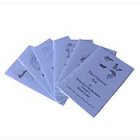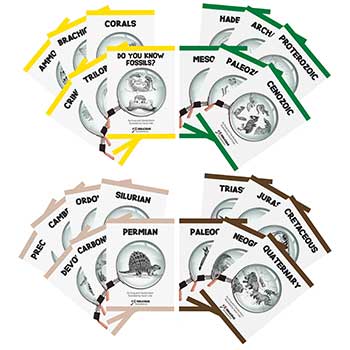Sign up for Lesson Plans, discounts & more!
A Lesson Plan on Fossilization
Lesson: What is Fossilization?Notes for the leader/teacher: We recommend that you say as little as possible in each lesson, giving your students opportunities to think and express their own ideas. Dialogue is included in bold and italics. Things you would do during the lesson are in CAPITAL LETTERS.
Goal: To experience how fossils are formed
Materials:
- An inexpensive fossil if you have one.
- Shrimp shell (A workable fossil substitute)
- Escargot shell (A workable fossil substitute)
- Plaster of Paris
- Pitcher of water
- Sifter
- Fine sand- must be fine enough to go through the sifter
- Waterproof container-small disposable aluminum baking pans work well.
- Small plastic or rubber dinosaur
This lesson plan has 2 parts. For part 2 click on the link at the bottom of the page that reads fossilization Lesson Plan Part 2; Fossil Excavation.
Part 1; The Process of Fossilization
Before
the lesson: Mix a small amount of fine sand with the plaster of Paris.
DO NOT ADD WATER. Put about a third of the dry mixture in a water proof
container. Separate the remaining mixture into two containers. Mix a
small amount of dry tempera paint to create different shades of brown.
Mix the colors into the containers to make two distinct colors of
powdery sand so the layers will show as different “soil” as it is added.
Introduction To Fossilization:
- PASS AROUND
SOME SAMPLE FOSSILS. If possible, have examples of both cast and mold
varieties. For an even better impression, try to have a sample that is
the positive/negative impression of both cast and mold of the same
fossil. How are fossils formed? What do you notice about these
fossils? What seems the same? What seems different? How do you think the
differences happened?
Your discussion could include experiences they might have had: making playdoh molds, baking a bundt cake, making molded candies or a Jell-O mold. In fact, for fun, you could have a snack ready of a jello mold for the end of the lesson. If you can find a lobster mold, you’d even be keeping with the theme! - Scientists think that life in the ancient seas might have been similar to modern sea life in many ways. The water would have been salty. There would have been lots of plant life for animals to feed on. There would have been animals, but in the ancient times, there were only the kinds of animals that had no backbones. We call these invertebrates. These animals often had skeletons on the outside of their bodies, an exoskeleton. We know about them because of fossilization.Continue your discussion, painting the picture of an ancient sea habitat. Talk about the animal species that would have made the seas their home. Compare them to modern animals that might have similar characteristics. Ask the students to imagine what would have happened to the animals’ bodies when they died. As they fell to the sea floor their shells would have become buried and filled with the soft sand of the ocean bottoms. This is where we begin to answer the question “How does fossilization take place?”
- BRING OUT THE PREPARED CONTAINER OF PLASTER OF PARIS. This is a model of the ancient sea floor. It is soft, sandy and powdery. The only difference is that it isn’t wet. This will be the final resting place of our shellfish. PLACE THE SHELLS IN THE DRY PLASTER OF PARIS.
- POUR A SMALL AMOUNT OF WATER ONTO THE LAYER OF PLASTER OF PARIS AND SHELLS. Adding water reminds us that this is a model of the ancient ocean. The ancient animals’ bodies would be exposed to ocean currents and wave movement on the sea floor. As the soft body decomposed or became some other animal’s dinner, the hard shell would fill up with sediments and mineral laden water.
- USING THE SIFTER, SIFT A SMALL AMOUNT OF THE REMAINING PLASTER AND SAND EVENLY OVER THE WATER, ALLOWING IT TO SINK IN AND COVER THE SHELLS. Sand and other sediments would eventually cover the ancient animals’ bodies.
- CONTINUE TO SIFT THE PLASTER UNTIL A SOFT, MUD IS FORMED. (Keep adding the plaster until all of the water is soaked up. The plaster will now dry fairly quickly. Plaster of Paris sets up in about 30 minutes.)
- This process could take a day a week, or even thousands or millions of years. Over time, the ancient sea might begin to dry up. There are lots of reasons this could have happened: movements of the earth’s crust, changes in temperature or volcanic actions could all change the depths of the ancient waters.
- TAKE A PLASTIC OR RUBBER DINOSAUR AND MAKE AN IMPRINT OF THEIR FOOT PRINTS. As the water level got lower and lower, muddy swamps and the thick vegetation they grew made good homes for species that could breathe the air, reptiles. As they walked or crawled through the swamps, their heavy bodies made tracks in the soft mud.
- Fossilization is a long slow process. It takes many thousands or millions of years for a fossil to form. Minerals in the water are left in tiny holes or pores in the shell or bone. Eventually one molecule at a time the minerals replace the original materials. What is left is a stone that looks exactly like the shell or bone that once was.
- ALLOW THE PLASTER TO DRY. You could proceed immediately using a prepared tray that is already hardened or you could end the lesson here and return to it when the tray is dry.
Fossilization Lesson Plan Part 2; Fossil Excavation
More fossil lesson plans
Check out some of the Educational Materials for sale on our sister site fossilicious.com.

interested in more? If so, you may want to check out our other sites:
fossilicious.com - Our online fossil and mineral rock shop.
rocksandminerals4u.com - An educational site about rocks, minerals, and geology.
Geologic Time Geologic Time Line
Cenozoic Era
Quaternary
Neogene
Paleogene
Mesozoic Era
Cretaceous
Jurassic
Triassic
Paleozoic Era
Permian
Carboniferous
Devonian
Silurian
Ordovician
Cambrian
Archean Time
Hadean Time
Teachers Resources
Activities for Education and Fun
Earth Science Lesson Plans
Activities For Kids
Fossil Lesson Plans
Fossil Activities
Education Articles
Coloring Pages
Dinosaur Coloring Pages
Montessori Materials
Geology Club
Fossil Hunting
 |
 |
 |




